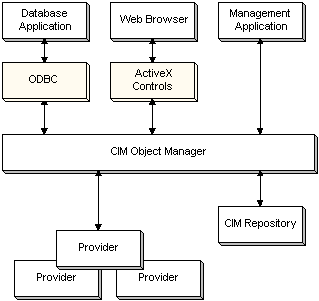Management Applications
A management application is an application or Microsoft® Windows NT® service that uses information originating from one or more managed objects. To access the information, a management application makes a request to CIMOM through one of the methods in the CIMOM API.
The WBEM technology enables management applications to implement a wide range of features such as producing reports of network inventory, displaying system information, responding to events, starting or stopping system services, and sending an "eject" command to a disk drive with replaceable media. Although some of the features can also be implemented without WBEM, much additional work is necessary.
WBEM supports a number of different strategies to implement management applications. Applications can access CIMOM directly through the CIMOM API or indirectly with one of the following access methods:
-
Web browsers can use a set of Microsoft® ActiveX® controls to control the appearance, relationships, and behavior of data relating to managed objects. The controls are customizable and can be included in a standard schema definition.
-
Web browsers can also use the Hypertext Markup Language (HTML, the standard HTML page and hyperlink paradigm. HTML is supported through an Internet Server API (ISAPI) layer that interacts with CIMOM.
-
Database applications can use the Microsoft® Open Database Connectivity (ODBC) driver to merge the database capabilities of ODBC with the management capabilities of WBEM. With the ODBC driver, an application can use a wide range of ODBC-based reporting packages and tools such as Microsoft® Visual Basic®, Microsoft Excel, and Microsoft Access.
-
The CIMOM API is available to both C/C++ programmers and to programmers writing in an Automation-compatible programming language. Therefore, applications written in C or C++ can use the primary version of the CIMOM API and applications written in Java or a scripting language such as Visual Basic can use the Automation-compatible version.
The following figure shows management applications of various types communicating with CIMOM. Two of the applications use one of the access strategies; one communicates directly to CIMOM.


